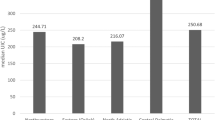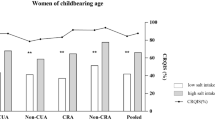Abstract
Objective: To assess the iodine status of New Zealand schoolchildren.
Design: A proportionate to population size school-based cluster survey was used to randomly select children from two cities. The indicators used to assess iodine status were urinary iodine, as determined in a casual urine sample, and thyroid volume, as measured by ultrasonography. A qualitative food frequency questionnaire designed to ascertain frequency of consumption over the previous 3 months of foods or food groups that are good sources of dietary iodine, including iodized salt, was administered to each child.
Setting: Dunedin and Wellington, New Zealand.
Participants: Three-hundred children aged 8–10 y from 30 schools.
Results: The median urinary iodine concentration of the children was 6.6 µg/dl (interquartile range, 4.5–9.1). The percentage of children who had urinary iodine levels less than 5 µg/dl was 31.4 (95% confidence interval (CI), 24.2–38.6). Comparison of thyroid volume with 2001 World Health Organization age/sex-specific and age/BSA-specific cut-off values resulted in a goitre prevalence of 11.3% (95% CI, 7.6–15.1) and 12.0% (95% CI, 7.9–16.1), respectively. Almost 30% of the children's caregivers did not use iodized salt in cooking and 51% of the children did not use iodized salt at the table.
Conclusions: Mild iodine deficiency was found in this sample of children. Iodized table salt may no longer be making a significant contribution to the iodine intakes of New Zealand children.
Sponsorship: This research was funded by the Health Research Council of New Zealand and the Ministry of Health in New Zealand.
This is a preview of subscription content, access via your institution
Access options
Subscribe to this journal
Receive 12 print issues and online access
$259.00 per year
only $21.58 per issue
Buy this article
- Purchase on Springer Link
- Instant access to full article PDF
Prices may be subject to local taxes which are calculated during checkout
Similar content being viewed by others
References
Anonymous. 2000 Standardization of ultrasound and urinary iodine determination for assessing iodine status: report of a technical consultation IDD Newsletter 16: 19–23
Azizi F, Kalani H, Kimiagar M, Ghazi A, Sarshar A, Nafarabadi M, Rahbar N, Noohi S, Mohajer M, Yassai M . 1995 Physical, neuromotor and intellectual impairment in non-cretinous schoolchildren with iodine deficiency Int. J. Vit. Nutr. Res. 65: 199–205
Benmiloud M, Chaouki ML, Gutekunst R, Teichert H-M, Wood WG, Dunn JT . 1994 Oral iodized oil for correcting iodine deficiency: optimal dosing and outcome indicator selection J. Clin. Endocrinol. Metab. 79: 20–24
Bleichrodt N, Escobar del Ray F, Morreale de Escobar G, Garcia I, Rubio C . 1989 Iodine deficiency, implications for mental and psychomotor development in children In: Iodine and the Brain ed. GR DeLong, J Robbins & PG Condliffe, pp 269–287 New York: Plenum Press
Bürgi H, Portmann L, Podoba J, Vertongen F, Srbecky M . 1999 Thyroid volumes and urinary iodine in Swiss school children Eur. J. Endocrinol. 140: 104–106
Cooper GJS, Croxson MS, Ibbertson HK . 1984 Iodine intake in an urban environment: a study of urine iodine excretion in Auckland NZ Med. J. 97: 142–145
Cressey PJ, Vannoort RW . 1998 Iodine Content of New Zealand Dairy Products Wellington: Ministry of Health/Institute of Environmental Science and Research Limited
Cressey PJ, Vannoort RW, Silvers K, Thomson B . 2000 1997/98 New Zealand Total Diet Survey Wellington: Ministry of Health
Delange F, Benker G, Caron P, Eber O, Ott W, Peter F, Podoba J, Simescu M, Szybinsky Z, Vertongen F, Vitti P, Wiersinga W, Zamrazil V . 1997 Thyroid volume and urinary iodine in European schoolchildren: standardization of values for assessment of iodine deficiency Eur. J. Endocrinol. 136: 180–187
Foo LC, Zulfiqar A, Nafikudin M, Fadzil MT, Asmah AS . 1999 Local versus WHO/International Council for Control of Iodine Deficiency Disorders-recommended thyroid volume reference in the assessment of iodine deficiency disorders Eur. J. Endocrinol. 140: 491–497
Gunton JE, Hams G, Fiegert M, McElduff A . 1999 Iodine deficiency in ambulatory participants at a Sydney teaching hospital: is Australia truly iodine replete? Med. J. Aust. 171: 467–470
Gutekunst R, Martin-Teichert H . 1993 Requirements for goiter surveys and the determination of thyroid size In: ed. F Delange, Jt Dunn & D Glinoer Iodine Deficiency in Europe, a Continuing Concern pp 109–118 New York: Plenum Press
Hess SY, Zimmermann MB . 2000 Thyroid volumes in a national sample of iodine-sufficient swiss school children: comparison with the World Health Organization/International Council for the Control of Iodine Deficiency Disorders normative thyroid volume criteria Eur. J. Endocrinol. 142: 599–603
Hetzel BS, Dunn JT . 1989 The iodine deficiency disorders: their nature and prevention A. Rev. Nut. 9: 21–38
Hetzel BS, Potter BJ, Dulberg EM . 1990 The iodine deficiency disorders: nature, pathogenesis and epidemiology World Rev. Nutr. Diet 62: 59–119
Hollowell JG, Staehling NW, Hannon WH, Flanders DW, Gunter EW, Maberly GF, Braverman LE, Pino S, Miller DT, Garbe PL, DeLozier DM, Jackson RJ . 1998 Iodine nutrition in the United States. Trends and public health implications: iodine excretion data from National Health and Nutrition Examination Surveys I and III (1971–1974 and 1988–1994) J. Clin. Endocrinol. Metab. 83: 3401–3408
Huda SN, Grantham-McGregor SM, Rahman KM, Tomkins A . 1999 Biochemical hypothyroidism secondary to iodine deficiency is associated with poor school ahievement and cognition in Bangladeshi children J. Nutr. 129: 980–987
Langer P, Tajtáková M, Podoba J, Kost'álová L, Gutekunst R . 1994 Thyroid volume and urinary iodine in school children and adolescents in Slovakia after 40 years of iodine prophylaxis Exp. Clin. Endocrinol. 102: 394–398
Li M, Ma G, Guttikonda K, Boyages SC, Eastman CJ . 2001 Re-emergence of iodine deficiency in Australia Asia Pacific. J Clin. Nutr. 10: 200–203
Liesenkötter KP, Kiebler A, Stach B, Willgerodt H, Grüters A . 1997 Small thyroid volumes and normal iodine excretion in Berlin schoolchildren indicate full normalization of iodine supply Exp. Clin. Endocrinol. Diabetes 105: 46–50
Lohman TG, Roche AF, Martorell R (eds). 1988 Anthropometric Standardization Reference Manual Champaign, IL: Human Kinetics
North KAK, Fraser S . 1965 Iodine intake as revealed by urinary iodine excretion NZ Med. J. 65: 512–513
Pino S, Fang SL, Braverman LE . 1998 Ammonium persulfate: a new and safe method for measuring urinary iodine by ammonium persulfate oxidation Exp. Clin. Endocrinol. Diabetes 106: S22–27
Purves HD . 1974 The aetiology and prophylaxis of endemic goitre and cretinism: the New Zealand experience NZ Med. J. 80: 477–479
Shrestha RM . 1994 Effect of Iodine and Iron Supplementation on Physical, Psychomotor and Mental Development in Primary School Children in Malawi Wageningen: Grafisch Service Centrum
Simpson FO, Thaler BI, Paulin EI, Cooper GJS . 1984 Iodine excretion in a salt restriction trial NZ Med. J. 97: 890–893
Sutcliffe E . 1990 Iodine in New Zealand milk Food Tech. NZ July 32–38
Thomson CD, Colls AJ, Conaglen JV, Macormack M, Stiles M, Mann J . 1997 Iodine status of New Zealand residents as assessed by urinary iodide excretion and thyroid hormones Br. J. Nutr. 78: 901–912
Valeix P, Preziosi P, Rossignol C, Farnier M-A, Hercberg S . 1994 Relationship between urinary iodine concentration and hearing capacity in children Eur. J. Clin. Nutr. 48: 54–59
Vitti P, Martino E, Aghini-Lombardi F, Rago T, Antonangeli L, Maccherini D, Paolo N, Loviselli A, Balestrieri A, Araneo G, Pinchera A . 1994 Thyroid volume measurement by ultrasound in children as a tool for the assessment of mild iodine deficiency J. Clin. Endocrinol. Metab. 79: 600–603
WHO & ICCIDD. 1997 Recommended normative values for thyroid volume in children aged 6–15 years Bull. WHO 75: 95–97
WHO, UNICEF & ICCIDD. 1993 Indicators for assessing iodine deficiency disorders and their control programmes WHO/NUT/93.1 Geneva: WHO
WHO, UNICEF & ICCIDD. 1994 Indicators for assessing iodine deficiency disorders and their control through salt iodization WHO/NUT/94.6 Geneva: WHO
Xu F, Sullivan K, Houston R, Zhao J, May W, Maberly G . 1999 Thyroid volumes in US and Bangladeshi schoolchildren: comparison with European schoolchildren Eur. J. Endocrinol. 140: 498–504
Zimmerman MB, Molinar L, Spehl M, Weidinger-Toth J, Podoba J, Hess S, Delange F . 2001 Updated provisional WHO/ICCIDD reference values for sonographic thyroid volume in iodine-replete school-age children IDD Newsletter 17: 12
Acknowledgements
We are indebted to Dr Neil Morrison of Otago Radiology for the use of the ultrasound machine and thank ultrasonographers Jill Muirhead, Annemieke Arron and Colin Gerrard. We gratefully acknowledge the help of Natassja Essed and Dianne Brown in Dunedin, Diana Clear in Wellington, technician Jody Joseph, and statistician Jo McKenzie. Finally we would like to thank all the children and their caregivers who participated in the study.
Author information
Authors and Affiliations
Corresponding author
Rights and permissions
About this article
Cite this article
Skeaff, S., Thomson, C. & Gibson, R. Mild iodine deficiency in a sample of New Zealand schoolchildren. Eur J Clin Nutr 56, 1169–1175 (2002). https://doi.org/10.1038/sj.ejcn.1601468
Received:
Revised:
Accepted:
Published:
Issue Date:
DOI: https://doi.org/10.1038/sj.ejcn.1601468
Keywords
This article is cited by
-
Use of Iodine Supplements by Breastfeeding Mothers Is Associated with Better Maternal and Infant Iodine Status
Biological Trace Element Research (2021)
-
Lebanese children are iodine deficient and urinary sodium and fluoride excretion are weak positive predictors of urinary iodine
European Journal of Nutrition (2017)
-
A comprehensive assessment of urinary iodine concentration and thyroid hormones in New Zealand schoolchildren: a cross-sectional study
Nutrition Journal (2012)
-
The changing epidemiology of iodine deficiency
Nature Reviews Endocrinology (2012)
-
Adequate iodine nutrition in Sweden: a cross-sectional national study of urinary iodine concentration in school-age children
European Journal of Clinical Nutrition (2009)



